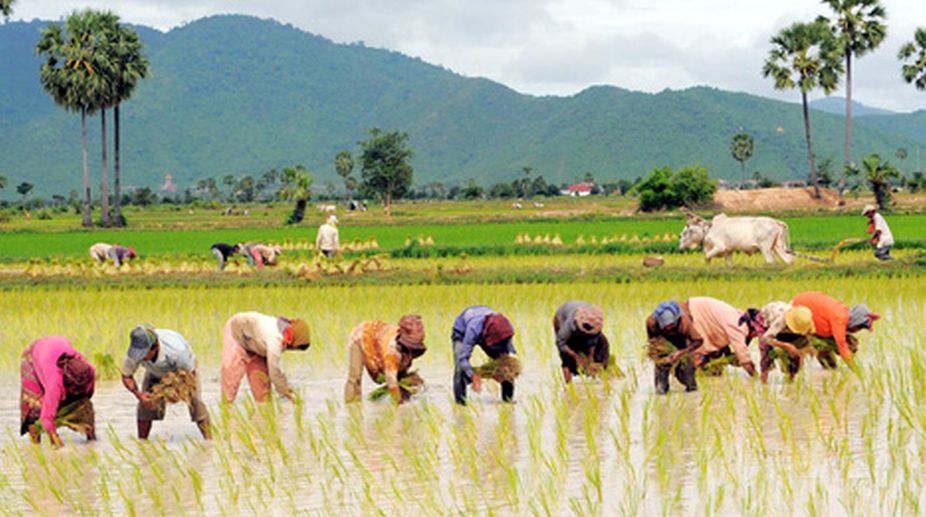In March 2016, in response to an RTI application, the Income Tax Department revealed that agricultural income earned by the 6.57 lakh assessees, who had filed returns in 2011, stood at nearly Rs 2,000 lakh crore. This was more than 20 times the country’s Gross Domestic Product of over Rs 84 lakh crore in that year. Subsequently, however, in January 2017, it clarified that the shocking figures were primarily due to data-entry errors, an assertion that is yet to be verified. But even extrapolation of the reduced income for all the identified cases implies that more than Rs 4000 crore of agricultural income were lying outside the tax-net.
Agriculture is exempt from income tax, under Section 2(1A) of the Income Tax Act which defines agricultural income as rent/revenue from land, income derived from this land through farming, and income derived from buildings on that land. Further, unless there is specific entry on tax in the Union or State List under the Seventh Schedule of the Constitution, no tax can be imposed by the Centre or the State government. The tax on agricultural income is listed under the State List (Entry 46), and hence the Central Government cannot tax such income. As such, Section 10 (1) of the Income Tax Act, a Central Act, excludes agricultural income from the computation of total income. Read with Section 2(1A), it implies that farmers who have no other sources of income are not required to file income-tax returns. It is only those farmers who derive income from sources other than agriculture who are required to file returns. If their agricultural income exceeds Rs 5000, and their total income is otherwise taxable, the agricultural income is to be added to the total income only for determination of their appropriate income-slab for charging of tax, but no tax will be imposed on the income derived from agriculture.
Advertisement
Any decision to tax agricultural income by the Centre will require an amendment to the Constitution. For that a “taxing entry” needs to be inserted in the Union List and appropriate changes should be made in Part XII of the Constitution, dealing with finances of the Union and the States. Of course, states have to be involved in the process, as presently they only can impose such a tax. It will be foolish to expect that states, already reeling in the face of agitations by farmers, will take the plunge. For the Centre, it will be a contentious issue, with different lobbying groups trying to protect the interests of the big farmers. But the danger of avoiding or postponing this will spell doom for the economy and defeat the Government’s earnest attempts to eliminate black money, as the untaxed agriculture sector will continue to absorb black money. It is also extremely unfair from considerations of equity and simplification of the tax administration.
In June 2016, at the Rajasva Gyan Sangam, an annual conference of tax administrators, a suggestion was advanced to the Prime Minister “on the need to target farmers with non-agricultural income above a certain threshold, an idea that was pitched as a low-hanging fruit that could potentially bolster ongoing efforts to widen the country’s taxpayer base.” Of the 25 crore taxpaying households in the country, 15 crore households are designated as agriculturalists and the remaining 10 crore are non-agriculturalists, according to estimates produced at the conference. Even earlier, several committees appointed by the Government had warned about the pitfalls of not taxing the agriculture sector.
The K N Raj Committee (1972), Tax Reforms Committee (1991), Task Force on Direct Taxes (2002), Tax Administration Reform Commission (2014) had all recommended taxation of agriculture to plug the loopholes for evasion and for the laundering of tax-evaded money. Despite pointing out the inherent inequity in exempting rich farmers earning more than salaried employees, nothing really has happened.
Actually, it is not even something unprecedented; agricultural income used to be taxed in India till 1886 when it was abolished. Income from tea, coffee and rubber plantations are taxed even now under Rules 8, 7A and 7B of the Income Tax Rules, 1962. But agriculture being the holy cow of the economy, any proposal to bring the sector as a whole under the tax net has always met with the strongest disapproval from the farmers’ lobby and the Government on the consideration of loss of vote-banks.
The vote-bank consideration is based on myth. Even if the sector is brought within the tax net, it is only a miniscule percentage of the total number of agricultural workers who would be affected. Even at present, hardly 2 per cent of the assessees declare any agricultural income. Even if small and marginal farmers are taxed, their income will be well below the tax threshold.
From the Agricultural Census and 2011 population census, we can estimate that the number of small and marginal farmers at 118 million (93 million marginal, 25 million small). They account for about 93 per cent of the total farmers in the country and together hold 45 per cent of the total area under cultivation. The remaining 7 per cent of the farmers, who share between them 55 per cent of the total cultivable land, would be the target group for any future tax on agriculture. They certainly do not constitute a major vote-bank, though their voice may be loud enough for any political party to yield to their demands for continued exemption. The agriculture sector contributes only 16 per cent to our GDP. Its growth has been stagnant, the percentages during 2012-13 to 2016-17 being only 1.5, 4.2, 0.2, 1.2 and 4.1 respectively. No significant capital investment has been made in agriculture during the past decades.
According to the Situation Assessment Survey of Agricultural Households conducted from January 2013 to December 2013, the average monthly income per agricultural household was estimated as Rs 6426. The net receipt from farm business (cultivation and farming of animals) accounted for about 60 per cent of the average monthly income per agricultural household. The average monthly consumption expenditure per agricultural household was Rs 6223, while the income was Rs 6426. Only for the large farmers holding more than 10 hectares of land, the income was Rs 41,388 per month, above the income tax threshold. These data show that only the large famers who account for a miniscule 0.70 percent of the total operational holdings will be liable to pay any income tax. They also have substantial non-farm income, above the tax threshold.
Even the agro-companies growing crops are entitled to the same tax reliefs as individuals in respect of agricultural income, which defies all logic when we consider the scale of exemptions enjoyed by these companies. For example, more than four lakh taxpayers had claimed exemption for agricultural income in the assessment year 2014-15. The biggest beneficiaries were Kaveri Seeds, which claimed Rs 186.63 crore as exemption, and multinational Monsanto India, which claimed Rs 94.40 crore as exemption, and they respectively earned Rs 215.36 crore and Rs 138.74 crore as profits before tax. Notably, Monsanto is the company that sells the genetically modified Bt-Cotton seeds in the country and earns huge profits. If this is not inequitable and irrational, one wonders what is. According to an estimate, taxing only the richest 4.1 per cent agricultural households, as much as Rs 25000 crore could be collected as tax. Given that only 2.6 per cent of the population paid any taxes in 2015-16 (39 per cent in the US for comparison), and only 25 lakh paid tax at the highest rate, then 90 per cent of them are from the organised sector where taxes are compulsorily deducted at source. If indeed we are serious about expanding the tax-base, this hitherto untaxed sector must be brought within the tax net.
Of course given the highly informal nature of business in this sector, tax administration will pose serious problems initially, but that is expected of any new domain. It should be ensured that the tax liability rests only on the shoulders of the rich farmers while insulating the small and marginal.
In 1925, the Indian Taxation Enquiry Committee had noted, “There is no historical or theoretical justification for the continued exemption from the income tax of income derived from agriculture. There are, however, administrative and political objections to the removal of the exemption at the present time.”
After more than 90 years, these words still ring the same. It is time for another disruptive and structural reform in this sphere.











